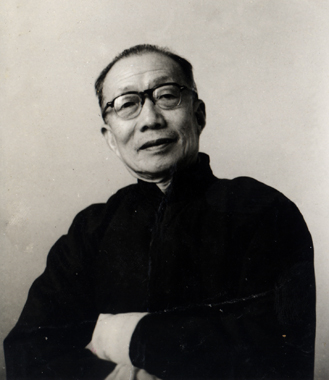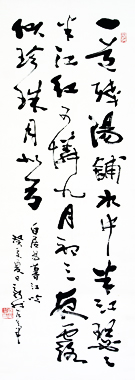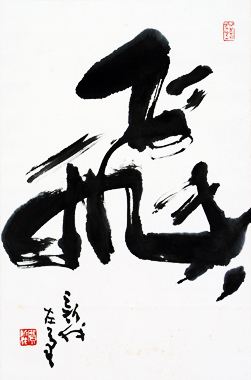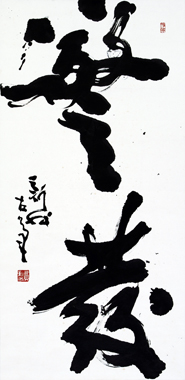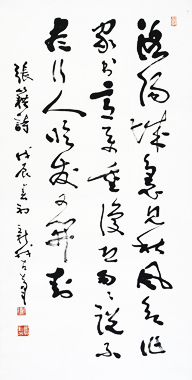Early in 1950s, Fei Xinwo, calligrapher and painter, was frequently engaged in receiving foreign cultural friends. He met with famous artists and art societies from USSR, Hungary, Germany, Brazil, Sweden, Finland, Australia, Indonesia and Japan in succession. Some of them had the friendship of art communication with him; some of them kept in touch with him by correspondence and sending reference to each other.
Fei’s right hand was disabled because of illness and he tried to practice calligraphy with his left hand. After ten years of hard working in such a way, he managed to develop the distinctive left-handed writing style. With the passage of time, his calligraphic works were characterized with the condensed passions and artful maneuver to the accompaniment of picturesque beauty. His works filled with momentum were appreciated and sought after by more and more people, which came to be accepted by foreigners.
In 1972, the icy relationship between China and Japan began to thaw. The journal People’s China, which was specially for Japanese readers, held a calligraphy forum in Suzhou. At the invitation, Fei Xinwo wrote down the calligraphic work of Mountain from Mao Zedong’s Ci, which When it won common praises upon being publishied. Mr. Guo Moruo was not stingy with his praises at the sight of this calligraphic work and said, “In this work, we can sense the protrusion of mountain rocks and meandering ranges hidden behind these words, which perfectly matches the meaning of poetry.” The publication of this work was the great release of Fei’s art practices and understandings over so many years, which also indicated that his calligraphy had landed on a new height and began to enter the international art world.
In the fall of 1978, Deng Xiaoping who just came back to power visited Japan. Fei Xinwo wrote a works with “Close Neighbors Separated by a Strip of Water, Friendship should be Kept Forever” as the token of congratulation. On October 23rd, People’s Daily published the original photo and words of this calligraphic work on the front page, “On the occasion of vice president Deng’s visit to Japan, the Chinese government and the Japanese government will swap the ratified document of China-Japan Peace and Friendship Treaty. I humbly write down these words with the wish for the eternal friendship between two countries.” It was added with the following note “It was written by famous calligrapher Fei Xinwo with his left hand”.
On the right day of its publication, Mr. Fei was in his hometown—Shuanglin Town, Huzhou City of Zhejiang Province, giving a lecture to calligraphy amateurs. He gladly remarked, “Well, it is done well owing lots of thanks to Shao Huaze, head of the People’s Daily. He once came to Suzhou to discuss this arrangement with me. It is a significant thing and should be made perfect.” Ever since then, he got an honorary title of “calligraphic diplomat”. A fashion of left-handed writing rose immediately in Japan.
At the invitation of Japan-China Friendship Association, Fei Xinwo’s Calligraphic Works Exhibition was successively held in Tokyo and Osaka from January 21st, 1982, which was the first calligraphic show in his personal name undertaken by Beijing Rongbaozhai Art Gallery and sponsored by Daily Press in Japan. 230 works were divided into half to be displayed in two cities. Although it was just a personal calligraphic exhibition, it was rich with contents and marvels. It was chilling cold at that time, but people thronged the exhibition. The exhibition lasted for ten days with tremendous popularity, which made a stir and reaped the praises among famous Japanese calligraphers, painters, social and political celebrities.
At the exhibition hall of Tokyo Seibu Department Store, when the door was opened, what came into view was the calligraphic work with Fei Xinwo’s left-handed writing on six feet folios of four scrolls, which dazzled the eyes of audiences. This work was just the poem of famous poet Du Fu in Tang Dynasty, in which Du Fu described the marvelous art of sword dancer and narrated the story that famous calligrapher Zhang Xun was greatly inspired by this dance and made a huge progress in the cursive writing. Mr. Fei managed to integrate the lightness, heaviness, slowness, swiftness, rhythm, rhyme and strength, the elements of dance and Taiji boxing into his works. The vigorous momentum and unrestrained rhythm were embodied in these works, which enabled his works to be vivid with flavor and tone. His works brought the whole house down. Murakami Santou, then president of Japanese Calligraphers Association, took the initiative and put on the red label indicating his willingness of purchase. All the works were pinned with red labels in succession. At the age of 80, this senior master was affected by the warmth of the audiences and began to write the calligraphic works at the exhibition hall on the spot.
During the exhibition in Osaka, Mr. Fei gave a lecture of calligraphy at the invitation. He introduced the relationship between calligraphy and Taiji boxing. Blessed with Taiji and sword exercises for more than a decade, he showcased his Kongfu during the lecture. Inhaling a deep breath, he commenced Taiji boxing practices with two hands. Two hands were joined in the continuous flow with endless inner force and unique charms. Japanese friends could not help saying, “Chinese Taiji is the moving calligraphy while the calligraphy is the solidified boxing”.
The exhibition was graced by the presence of three famous Japanese calligraphers, Aoyama San’u, Bai Joteki, and Murakami Santou all of whom once visited China and came to know Mr. Fei at the art exchange of calligraphy. They respectively wrote an introductory essay as the preambles of the exhibition. Murakami Santou praised Mr. Fei as “not only an artist, but also a philosopher and a talent with ambitions.” Daily Press, TV Asashi and other media vied with each other in covering this event and described Mr. Fei as “an impressive calligrapher with unique writing style,” “the ambassador with hearts interwoven into the calligraphy”. Asashi Press, whose global circulation was ranked among the tops, praised Mr. Fei as “the Immortal of Ink”.
As it was just the beginning of Chinese open-up and reform, this exhibition to Japan organized by Rongbaozhai was actually burdened with a special mission, viz. to send out a trial balloon, to open Japanese calligraphy and painting market for Chinese artists. With the initial success of Fei Xinwo’s exhibition in Japan, other famous Chinese calligraphers and painters, such as Fan Zeng, Zheng Naiguang, Qi Gong, Huang Miaozi successfully held their exhibitions of personal works one by one. All of these were considered as the hard endeavors in pioneer work of enabling Chinese calligraphy and painting to enter the world.
In Tokyo, for the first time, Mr. Fei met with Ito Tokai, the 90-year-old Japanese calligrapher who kept correspondence with him for years. Their feelings were complicated because during the Cultural Revolution Mr. Fei was publicly criticized for his foreign correspondence and Ito’s calligraphy of Du Mu’s poem as a gift was therefore confiscated. When they saw each other, Ito said, “I’m so fortunate to survive to see you.” With these words, he wrote down five Chinese characters literally “Exhaust Myself to Greet Friends” on the spot, which was the token of a good friend.
During his stay in Japan, Mr. Fei also made quite a few new friends. Among them, there was Shigemori Suikei, who used to be the folk calligrapher and was then president of Thousands Miles Calligraphers Association, whose members were mostly women and housewives. Shigemori admired Mr. Fei very much and always presented his works for appreciation. After their first meeting, this Japanese friend even came to Suzhou to attend the cultural exchange many times. During their correspondence, Mr. Fei offered some incisive opinions as reference in addition to the calligraphic works. Since both of them were quite congenial to each other, they agreed to meet with each other every other year. When Shigemori celebrated his birthday of 77, he received a long scroll of calligraphy from Mr. Fei, which recorded the friendship over so many years. Unexpectedly, Mr. Fei passed away in 1992. However, his Japanese friend still kept his promise and came to Suzhou with other 9 delegates including his son, daughter and association members to pay homage to Mr. Fei’s tomb in 1994. In 1998, when he was 88 years old, he held an exhibition and compiled ten calligraphic works presented by Mr. Fei over years into the book after the exhibition.
Mr. Fei’s unique calligraphic skills attracted Japanese calligraphers and they always wanted to see the writing with their own eyes. One year, a Japanese delegation visited China. Mr. Fei was just in Nanjing and invited to demonstrate his skills on the spot. Since the time was brief with so many audiences, it seemed that everything was arranged, the young audiences on the front row squatted one by one, propping their jaws on the table, while the audiences of the second row inserted their heads between the shoulders of those at the first row. In this way, three or four rows had been set neatly in a quiet way within a few minutes. Although it was not comfortable at all, it was guaranteed that everyone could see the whole process clearly. The head of the delegation and interpreter could walk around as they liked. With more than hundreds of eyes fixed on the paper in an earnest way, it was just like a picture in which hundreds of eyes were cast into the tip of brush, waiting for the astonishing work. Mr. Fei was astounded at this sight. After having dipped his brush into the ink, inhaling a deep breath and holding it, he wrote down his works to the heart’s content. He told his third son this vivid event after he came back to Suzhou.
Early in the beginning of 1970s, Mr. Fei made a remarkable contribution to the exchange between Suzhou and Japanese cultural circle, entrepreneurs and international friendly cities. Mr. Fei was held in great esteem and trusted by the leaders at different levels of Suzhou city. He was arranged to participate in many important activities concerning foreign affairs. During that period, whenever there were Japanese calligraphy and painting exhibitions or calligraphic exchange between Japanese and Chinese artists, Mr. Fei would always receive these guests and write down the calligraphic works. In the meanwhile, many of his calligraphic works were brought to Japan as the presents in token of Japanese entrepreneurs and friends.
On June 6th, 1981, Suzhou and Ikeda became the international friendly cities. Entrusted by the Office of Foreign Affairs of Suzhou City, Mr. Fei became the friendship ambassador. During the course of holding exhibition, he specially came to the municipal government of Ikeda and became the guest of Koyama Toubee, then president of Ikeda-Suzhou Friendship Association accompanied by vice mayor of Ikeda. Ms Koyama made a meal in person and entertained this distinguished guest with delicate Japanese food. Later, whenever the couple came to Suzhou to hear the bell at Hanshan Temple, Mr. Fei would always meet with them.
After establishing the bond of friendly cities, Suzhou Municipal Government decided to present a pavilion of six corners to Ikeda city as the eternal souvenir of friendship between two cities. The head of Foreign Affairs Office of Suzhou specially invited Mr. Fei to nominate this pavilion. After thinking for a while, Mr. Fei offered to nominate it as “Parallel Fragrance Pavilion”, which meant two cities could be equal on sharing beauty and fragrance. His suggestion was accepted in unison. On June 6th, 1984, to commemorate the 3rd anniversary of becoming friendly cities, Fang Ming, then mayor of Suzhou headed a delegation to visit Ikeda and presided over the ceremony of presenting “Parallel Fragrance Pavilion”, hanging the inscribed board on the pavilion. Henceforth, this Pavilion situated in the Water and Moon Park has become the new icon of Ikeda city. On the envelop of Ikeda Municipal Government and visiting cards of some officials, there are photos of “Parallel Fragrance Pavilion” with the inscription of Mr. Fei.
